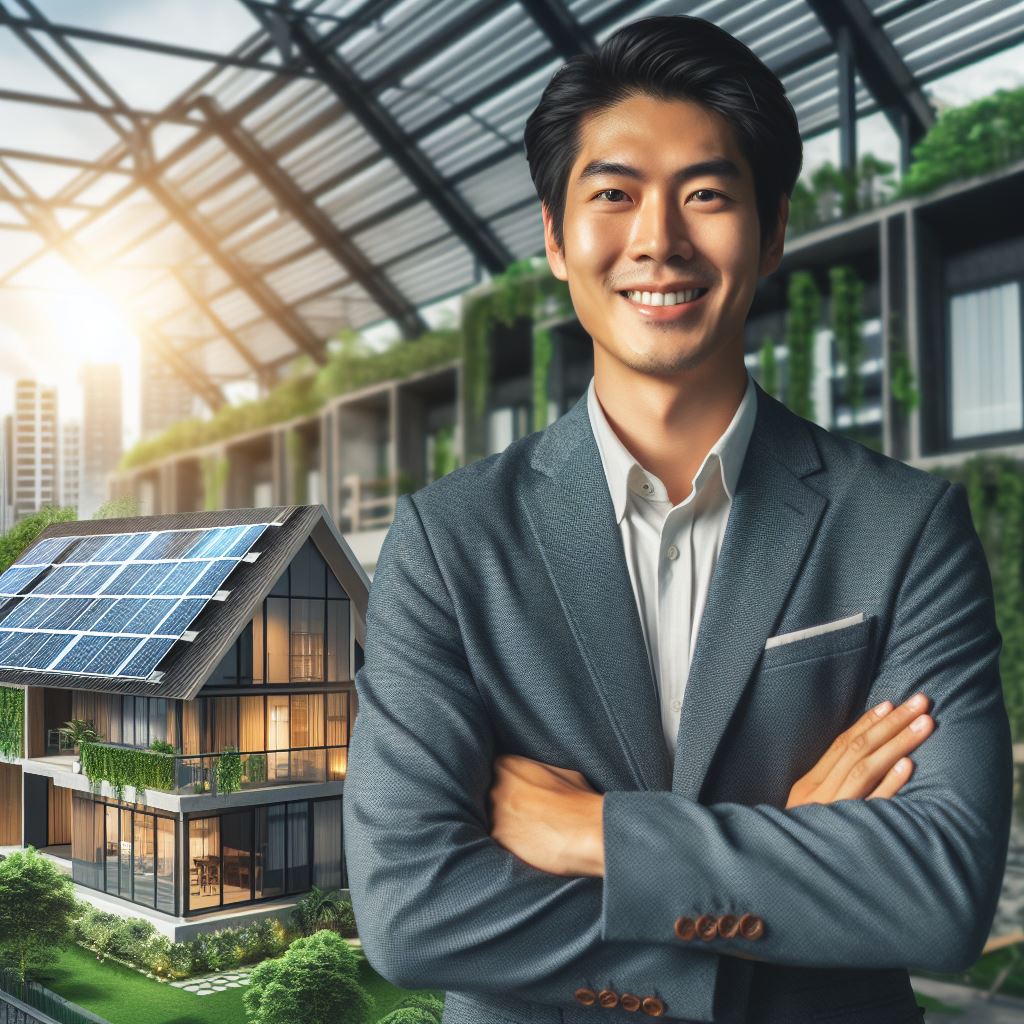Eco-Friendly Construction: The Future in the US
Last Updated on February 6, 2024
Introduction
Eco-friendly construction refers to the use of sustainable materials and energy-efficient design techniques to minimize environmental impact.
Eco-friendly construction is crucial in the US to combat climate change, reduce pollution, and conserve natural resources.
By implementing eco-friendly construction practices, we can significantly decrease carbon emissions and promote a healthier environment.
This approach includes using renewable energy sources, such as solar panels, and adopting energy-efficient insulation, lighting, and HVAC systems.
Additionally, eco-friendly construction reduces waste generation and promotes recycling and reuse of materials, aiming for a more circular economy.
The benefits of eco-friendly construction extend beyond the environment; it improves indoor air quality and enhances occupant health and well-being.
Eco-friendly buildings often have lower operating costs due to reduced energy consumption and maintenance requirements.
The US government recognizes the significance of eco-friendly construction and has introduced incentives and certifications like LEED to encourage adoption.
Businesses and individuals alike are increasingly embracing eco-friendly construction as they realize the long-term economic and environmental advantages.
In essence, eco-friendly construction is essential in the US to create sustainable and resilient buildings that have minimal environmental impact.
By prioritizing eco-friendly construction practices, we can build a greener future for generations to come.
Benefits of Eco-Friendly Construction
Eco-friendly construction brings numerous benefits, not only for the environment but also for the economy. Let’s explore these advantages in more detail.
Environmental advantages
1. Reduction of carbon footprint
Traditional construction methods contribute to significant carbon emissions.
In contrast, sustainable building practices focuses on reducing carbon footprint by utilizing sustainable practices and materials.
This includes incorporating energy-efficient systems, using renewable energy sources, and implementing proper waste management strategies.
By minimizing emissions, sustainable building practices helps combat climate change and improve air quality.
2. Conservation of natural resources
Conventional construction consumes vast amounts of natural resources, such as water, timber, and minerals.
In eco-friendly construction, resource conservation is prioritized through the use of sustainable materials, such as recycled or salvaged materials, as well as implementing efficient systems that minimize waste generation.
By conserving natural resources, sustainable building practices helps preserve ecosystems and reduces environmental degradation.
3. Preservation of biodiversity
Traditional construction often leads to habitat destruction, threatening biodiversity.
On the contrary, eco-friendly construction takes measures to protect biodiversity by preserving existing green spaces, avoiding the destruction of natural habitats, and incorporating sustainable landscaping practices.
The preservation of biodiversity is crucial for maintaining ecological balance and supporting the overall health of ecosystems.
Economic advantages
1. Lower energy costs over time
Eco-friendly buildings are designed to be energy-efficient, reducing long-term energy consumption and costs.
Utilizing energy-efficient appliances, insulation, and lighting systems helps minimize energy usage, resulting in lower utility bills.
Over time, the savings on energy costs can significantly offset the initial investment in sustainable building practices.
2. Increased property value
Eco-friendly construction is highly sought after by environmentally conscious buyers and tenants.
Green buildings command higher selling prices and rental rates due to their lower environmental impact and improved indoor air quality.
Eco-friendly buildings offer enhanced comfort and improved health benefits to occupants, further increasing their value in the real estate market.
3. Government incentives and tax benefits
Governments recognize the importance of sustainable construction and offer various incentives to promote eco-friendly practices.
These incentives can include grants, subsidies, and tax benefits for builders and homeowners who adopt sustainable building practices methods.
These financial incentives not only lower the initial costs of eco-friendly construction but also encourage more individuals and organizations to embrace sustainable building practices.
In fact, sustainable building practices provides significant benefits both for the environment and the economy.
By reducing carbon footprint, conserving natural resources, and preserving biodiversity, eco-friendly construction helps protect the planet for future generations.
Simultaneously, lower energy costs, increased property value, and government incentives make sustainable building practices a financially attractive option.
Embracing eco-friendly construction practices is essential for a sustainable future in the United States and beyond.
Read: 2024’s Top Commercial Developments in the US
Innovations in Eco-Friendly Construction
When it comes to sustainable building practices, innovation takes center stage.
The future of construction in the US lies in adopting sustainable practices and incorporating advanced technologies.
Here are some key innovations in eco-friendly construction that are already gaining prominence:
Sustainable materials
- Use of recycled or reclaimed materials: Builders are increasingly using materials with recycled content, such as reclaimed wood and recycled steel, reducing the demand for virgin resources.
- Low-emitting materials: Eco-friendly construction prioritizes the use of materials with low or no volatile organic compounds (VOCs) to improve indoor air quality and reduce environmental impact.
- Energy-efficient appliances and fixtures: Incorporating energy-efficient appliances and fixtures into construction projects helps reduce electricity consumption and promotes sustainability.
Energy-efficient design and technology
- Passive solar design: By optimizing the orientation and layout of buildings and utilizing windows, insulation, and shading, passive solar design maximizes natural light and heat, reducing the need for artificial lighting and heating.
- High-performance insulation: Advanced insulation materials, such as spray foam and insulated concrete forms, enhance energy efficiency by minimizing heat transfer and reducing heating and cooling costs.
- Smart home automation: Equipping buildings with intelligent automation systems allows for real-time monitoring and control of energy usage, optimizing efficiency and reducing waste.
Waste reduction and recycling
- Construction and demolition waste management: Implementing effective waste management strategies during construction and demolition projects helps divert materials from landfills and encourages recycling.
- On-site recycling programs: Setting up on-site recycling programs enables the reuse of construction waste, such as concrete, asphalt, and wood, reducing the need for new materials.
- Composting and waste-to-energy initiatives: Embracing composting and waste-to-energy technologies provides sustainable ways to repurpose organic waste and generate renewable energy.
These innovations in eco-friendly construction not only contribute to a more sustainable future but also offer several advantages.
They help reduce greenhouse gas emissions, conserve resources, enhance the durability and performance of buildings, and create healthier indoor environments.
Moreover, investing in sustainable building practices can lead to long-term cost savings through reduced energy consumption and maintenance expenses.
Eco-friendly construction is the future of the US construction industry.
With the adoption of sustainable materials, energy-efficient design and technology, and waste reduction and recycling strategies, builders can contribute to a greener and more sustainable built environment.
Embracing these innovations is not only beneficial for the environment but also for the long-term health, comfort, and economic prosperity of communities across the country.
Read: Retail Real Estate Loans: A Comprehensive Guide

Case Studies of Successful Eco-Friendly Construction Projects in the US
In the pursuit of a more sustainable future, the United States has witnessed numerous successful eco-friendly construction projects.
These projects serve as inspiring case studies, demonstrating the feasibility and advantages of incorporating environmentally responsible practices into building and design processes.
LEED-certified buildings
One prominent certification program in the US is the Leadership in Energy and Environmental Design (LEED) certification.
Many buildings across the country have achieved LEED certification, proving their commitment to sustainability.
1. LEED Platinum projects
LEED Platinum is the highest level of certification awarded by the program.
Several LEED Platinum projects showcase excellence in sustainable building practices and design. One such project is the Bank of America Tower in New York City.
This skyscraper incorporates energy-efficient systems, advanced air filtration, and a rainwater collection system.
2. Energy-efficient features and sustainable practices
LEED-certified buildings prioritize energy efficiency and sustainable practices.
For instance, the Salesforce Tower in San Francisco features high-performance glass, solar panels, and a water recycling system.
These elements ensure reduced energy consumption, optimized water usage, and a minimized carbon footprint.
Green affordable housing initiatives
Aside from commercial buildings, sustainable building practices initiatives also extend to the housing sector.
Green affordable housing initiatives aim to provide environmentally responsible and affordable homes to low-income communities.
1. Low-income housing incorporating eco-friendly elements
One notable example is the Make It Right project in New Orleans.
Spearheaded by actor Brad Pitt, this initiative transformed a neighborhood devastated by Hurricane Katrina into an eco-friendly community.
The houses are designed to withstand floods, feature solar panels, and use sustainable materials.
2. Benefits for residents and the community
Green affordable housing projects bring numerous benefits to residents and the community at large.
These homes offer lower utility bills due to their energy-efficient design, improving financial stability for low-income families.
The use of sustainable materials and technologies reduces the overall environmental impact, leading to healthier living conditions for residents.
In general, case studies of successful sustainable building practices projects in the US provide valuable insights and inspiration for a more sustainable future.
LEED-certified buildings, particularly those achieving Platinum status, demonstrate the potential for energy-efficient features and sustainable practices.
Furthermore, green affordable housing initiatives showcase how low-income communities can benefit from eco-friendly elements, both economically and environmentally.
As more such projects emerge, eco-friendly construction is undoubtedly becoming the future of building in the US.
Read: Emerging CRE Markets: 2024 Guide
Challenges and Future Outlook
Cost considerations and misconceptions
One major challenge faced by esustainable building practices is higher initial costs.
However, many fail to consider long-term benefits, such as reduced energy consumption and operating costs.
Educating individuals about these benefits can help dispel misconceptions and encourage more investment in eco-friendly construction.
Advancements in technology and increased demand are gradually driving down the costs of eco-friendly materials and techniques.
Over time, this will make eco-friendly construction more affordable, further promoting its adoption.
Regulatory challenges and outdated policies
Outdated policies and regulations often pose significant challenges to the widespread adoption of eco-friendly construction practices.
Many existing codes and standards do not adequately address sustainable building practices, making it difficult for builders to incorporate sustainable elements.
The lack of clear guidelines and standardized processes hinders progress in the industry.
It is crucial for governments and regulatory bodies to update their policies, incentivize sustainable construction, and remove barriers.
By creating a supportive regulatory framework, the industry can flourish and drive the transition towards a greener future.
Importance of education and awareness
Education and awareness play a vital role in the advancement of sustainable building practices in the United States.
Many individuals, including contractors and consumers, may lack knowledge about sustainable building practices.
Efforts should be made to promote understanding of the environmental and economic benefits of eco-friendly construction.
Workshops, seminars, and awareness campaigns can empower stakeholders and encourage them to embrace sustainable alternatives.
Investing in educational programs and promoting green certifications will further strengthen the industry and create a knowledgeable workforce.
Potential for growth and expansion of eco-friendly construction
Despite the challenges faced, the future outlook for sustainable building practices in the US is promising.
As sustainability becomes a more pressing global concern, the demand for eco-friendly buildings will continue to rise.
The construction industry has already witnessed a shift towards greener practices, and this trend is expected to accelerate.
Technological advancements, increased awareness, and government support will fuel the growth of eco-friendly construction.
The industry holds immense potential for creating jobs, reducing carbon emissions, and improving the overall quality of built environments.
Collaboration between stakeholders, including designers, contractors, developers, and policymakers, is essential for ensuring a sustainable and eco-friendly future.
In review, sustainable building practices in the US faces challenges in terms of cost considerations, outdated policies, and a need for increased education and awareness.
However, the industry also presents significant opportunities for growth and expansion.
By addressing these challenges, updating regulations, and fostering education and awareness, the US can move closer to a sustainable future where eco-friendly construction is the norm rather than the exception.
Read: Evaluating Loan Options for Office Buildings
Conclusion
Eco-friendly construction plays a crucial role in mitigating environmental impacts, reducing carbon emissions, and promoting sustainable development.
It is imperative for individuals and industries to adopt eco-friendly practices to preserve natural resources and create a healthier and more sustainable future.
By embracing sustainable building practices, we can look forward to a future with reduced energy consumption, improved air and water quality, and overall enhanced quality of life for everyone.
As we move forward, it is essential for all stakeholders to prioritize sustainable building practices practices, such as using renewable materials, implementing energy-efficient technologies, and reducing waste.
Together, we can create a built environment that is not just aesthetically pleasing and functional, but one that is also in harmony with nature.
The benefits of eco-friendly construction reach far beyond immediate cost savings – they impact the health and well-being of future generations.
Let us seize the opportunity to make a positive impact on the environment, protect our natural resources, and leave a legacy of sustainable infrastructure for generations to come.


